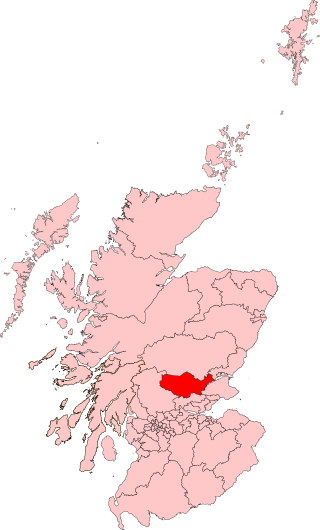Related Research Articles

East Dunbartonshire was a county constituency of the House of Commons of the Parliament of the United Kingdom (Westminster). It elected one Member of Parliament (MP) by the first past the post system of election. The seat is possibly best known for formerly being the constituency of Jo Swinson, the former Leader of the Liberal Democrats who was defeated at the 2019 general election.

Motherwell and Wishaw was a burgh constituency of the House of Commons of the Parliament of the United Kingdom. It was first created in 1974, mostly from the former Motherwell constituency. In 1983, it was split into two constituencies, Motherwell North and Motherwell South; but these were re-amalgamated in 1997.
Ross and Cromarty was a county constituency of the House of Commons of the UK Parliament from 1832 to 1983. It elected one Member of Parliament (MP) using the first-past-the-post voting system.
Glasgow Kelvingrove was a burgh constituency represented in the House of Commons of the Parliament of the United Kingdom from 1918 until 1983. It elected one Member of Parliament (MP) using the first-past-the-post voting system. In February 1974 it absorbed the entire Glasgow Woodside Constituency which had existed from 1950 but lost the part of the Exchange Ward it had previously included to Glasgow Central.
South Ayrshire was a county constituency of the House of Commons of the Parliament of the United Kingdom from 1868 until 1983, when it was abolished. It returned one Member of Parliament (MP), elected by the first past the post voting system.
Bothwell was a county constituency in Lanarkshire represented in the House of Commons of the Parliament of the United Kingdom from 1918 to 1983. It was formed by the division of Lanarkshire constituency.
Coatbridge was a parliamentary constituency represented in the House of Commons of the Parliament of the United Kingdom. It returned one Member of Parliament (MP) from 1918 to 1950, elected by the first past the post voting system.
Hamilton was a burgh constituency represented in the House of Commons of the Parliament of the United Kingdom from 1918 to 1997. It elected one Member of Parliament (MP) by the first past the post voting system.
Lanark was a county constituency of the House of Commons of the Parliament of the United Kingdom (Westminster) from 1918 to 1983. It elected one Member of Parliament (MP) by the first past the post voting system.

Rutherglen is a burgh constituency represented in the House of Commons of the Parliament of the United Kingdom since 2024. It also existed between 1918 and 2005 and was largely replaced by Rutherglen and Hamilton West while a small portion became part of Glasgow Central and Glasgow South.
Clackmannan and Eastern Stirlingshire was a parliamentary constituency in the Clackmannan area of Central Scotland. It returned one Member of Parliament (MP) to the House of Commons of the Parliament of the United Kingdom, elected by the first past the post system.
Dunbartonshire was a county constituency of the House of Commons of Great Britain from 1708 to 1801 and of the House of Commons of the Parliament of the United Kingdom from 1801 to 1950.

Perth was a constituency of the House of Commons of the Parliament of the United Kingdom from 1832 to 1918, 1918 to 1950, and 1997 to 2005. From 1832 to 1918 it was a burgh constituency. From 1918 to 1950, and 1997 to 2005, it was a county constituency. During each of the three periods it elected one Member of Parliament (MP).
Bute and Northern Ayrshire was a county constituency of the House of Commons of the Parliament of the United Kingdom from 1918 to 1983. It elected one Member of Parliament (MP) by the first past the post voting system.
Angus North and Mearns was a county constituency represented in the House of Commons of the Parliament of the United Kingdom from 1950 to 1983. It elected one Member of Parliament (MP) by the first past the post voting system.
NorthLanarkshire was a county constituency of the House of Commons of the Parliament of the United Kingdom (Westminster) from 1868 to 1885 and from 1918 to 1983. It elected one Member of Parliament (MP) by the first past the post voting system.
North West Lanarkshire was a county constituency of the House of Commons of the Parliament of the United Kingdom (Westminster) from 1885 to 1918. It elected one Member of Parliament (MP) by the first past the post voting system.
Inverness was a county constituency of the House of Commons of the Parliament of the United Kingdom from 1918 until 1983. It elected one Member of Parliament (MP) by the first-past-the-post system of election.
Ayr Burghs was a district of burghs constituency of the House of Commons of the Parliament of Great Britain from 1708 to 1800 and of the House of Commons of the Parliament of the United Kingdom from 1801 to 1950. It elected one Member of Parliament (MP), using the first-past-the-post voting system.
Kirkcaldy Burghs was a burgh constituency of the House of Commons of the Parliament of the United Kingdom (Westminster) from 1832 to 1974. It elected one Member of Parliament (MP) by the first-past-the-post voting system. From 1832 to 1950 it was, officially, a district of burghs constituency.